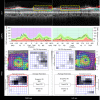Optic nerve head injury and optical coherence tomography angiography
- PMID: 34604003
- PMCID: PMC8408792
- DOI: 10.21037/qims-20-1218
Optic nerve head injury and optical coherence tomography angiography
Conflict of interest statement
Conflicts of Interest: Both authors have completed the ICMJE uniform disclosure form (available at http://dx.doi.org/10.21037/qims-20-1218). The authors have no conflicts of interest to declare.
Figures





Similar articles
-
Optical coherence tomography angiography of the macula and optic nerve head: microvascular density and test-retest repeatability in normal subjects.BMC Ophthalmol. 2018 Dec 10;18(1):315. doi: 10.1186/s12886-018-0976-y. BMC Ophthalmol. 2018. PMID: 30526537 Free PMC article.
-
SWEPT-SOURCE OPTICAL COHERENCE TOMOGRAPHY ANGIOGRAPHY OF THE OPTIC DISK IN OPTIC NEUROPATHY.Retina. 2016 Dec;36 Suppl 1:S168-S177. doi: 10.1097/IAE.0000000000001259. Retina. 2016. PMID: 28005675
-
Optical coherence tomography angiography in nonarteritic anterior ischemic optic neuropathy due to optic nerve head drusen.Neurol Sci. 2020 Nov;41(11):3349-3351. doi: 10.1007/s10072-020-04493-4. Epub 2020 Jun 1. Neurol Sci. 2020. PMID: 32483688
-
Optical Coherence Tomography Angiography of the Optic Disc; an Overview.J Ophthalmic Vis Res. 2017 Jan-Mar;12(1):98-105. doi: 10.4103/2008-322X.200162. J Ophthalmic Vis Res. 2017. PMID: 28299012 Free PMC article. Review.
-
Optical coherence tomography evaluation of the optic nerve head neuro-retinal rim in glaucoma.Clin Exp Optom. 2019 May;102(3):286-290. doi: 10.1111/cxo.12833. Epub 2018 Sep 7. Clin Exp Optom. 2019. PMID: 30192017 Review.
Cited by
-
Optical Coherence Tomography Angiography Assessment of the Optic Nerve Head in Patients Hospitalized Due to COVID-19 Bilateral Pneumonia.Medicina (Kaunas). 2024 Mar 19;60(3):502. doi: 10.3390/medicina60030502. Medicina (Kaunas). 2024. PMID: 38541228 Free PMC article.
References
-
- Manalastas PIC, Zangwill LM, Daga FB, Christopher MA, Saunders LJ, Shoji T, Akagi T, Penteado RC, Yarmohammadi A, Suh MH, Medeiros FA, Weinreb RN. The Association Between Macula and ONH Optical Coherence Tomography Angiography (OCT-A) Vessel Densities in Glaucoma, Glaucoma Suspect, and Healthy Eyes. J Glaucoma 2018;27:227-32. 10.1097/IJG.0000000000000862 - DOI - PMC - PubMed
-
- Yarmohammadi A, Zangwill LM, Diniz-Filho A, Suh MH, Manalastas PI, Fatehee N, Yousefi S, Belghith A, Saunders LJ, Medeiros FA, Huang D, Weinreb RN. Optical Coherence Tomography Angiography Vessel Density in Healthy, Glaucoma Suspect, and Glaucoma Eyes. Invest Ophthalmol Vis Sci 2016;57:OCT451-9. 10.1167/iovs.15-18944 - DOI - PMC - PubMed
LinkOut - more resources
Full Text Sources
